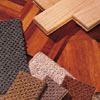Choosing Floor Coverings
One of the quickest ways to give your home a fresh new look is with new flooring and carpeting. However, there are so many different products available that homeowners are sometimes overwhelmed by their choices. Consulting with knowledgeable professionals will help you choose flooring materials that meet your needs and budget.
 Q: Is it better to pull up my old floor or can new vinyl
flooring be installed over the top of it?
Q: Is it better to pull up my old floor or can new vinyl
flooring be installed over the top of it?
A: Depending on your situation, it is usually better to lay new flooring directly to the concrete or wood underlayment. There are times when you should install over the existing floor, however.
- If you have a moisture problem, then leaving the older layer in place will act as a moisture barrier and protect the new flooring from discoloring.
- The age of your old floor also plays a significant part in determining whether to pull it up. OSHA requires testing of floors installed before 1978. If asbestos is present in your old floor, it must be removed by a licensed asbestos abatement company, which can be expensive. Homeowners often opt to save time and money by just covering it over with new flooring.
Q: Can my vinyl flooring be repaired?
A: Yes, in most cases your floor can be repaired with excellent results. It is important that the seams are sealed with the correct sealer after the repair is made. Whenever you buy new flooring material, be sure to keep some scraps on hand for this purpose.
Q: I need to buy new carpet but I find it difficult to tell which carpets are better than others.
A: At this time, there is no standard rating system, each carpet mill has its own. The best way to determine the quality of carpet is to meet with a professional who can help you determine your needs. This person should be knowledgeable enough to show you the styles that meet your need and budget, and explain the twist and density, which will help you make an educated decision.
Q: Can you make my carpet seams invisible?
A: In most cases, your seams should not be noticeable. Of course, this will depend upon the type of carpet you have selected, the placement of the seams, the way light hits the seams and the workmanship. Before you buy your carpet, it is a good idea to discuss how and where the carpet will be seamed with your contractor. In many cases it is worthwhile to purchase a few extra yards of carpet so seams can be positioned better or even eliminated.
by Kathy Maynard, reprinted courtesy of HomeAdvisor.com